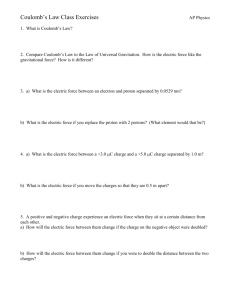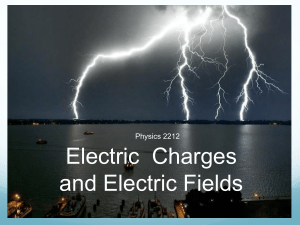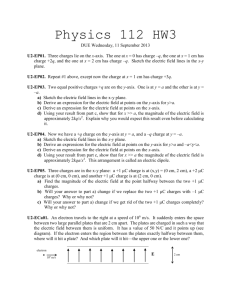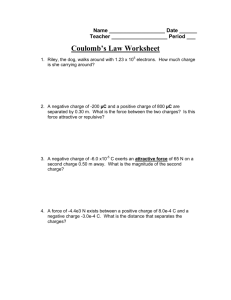p212_studyguide_U1
advertisement
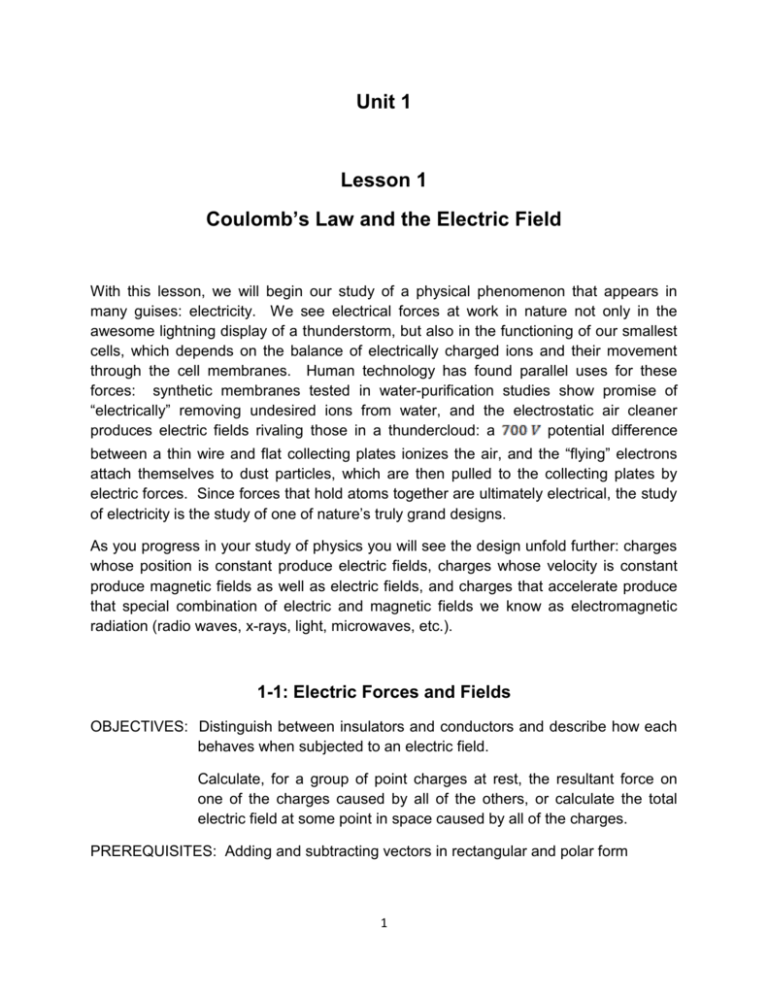
Unit 1 Lesson 1 Coulomb’s Law and the Electric Field With this lesson, we will begin our study of a physical phenomenon that appears in many guises: electricity. We see electrical forces at work in nature not only in the awesome lightning display of a thunderstorm, but also in the functioning of our smallest cells, which depends on the balance of electrically charged ions and their movement through the cell membranes. Human technology has found parallel uses for these forces: synthetic membranes tested in water-purification studies show promise of “electrically” removing undesired ions from water, and the electrostatic air cleaner produces electric fields rivaling those in a thundercloud: a potential difference between a thin wire and flat collecting plates ionizes the air, and the “flying” electrons attach themselves to dust particles, which are then pulled to the collecting plates by electric forces. Since forces that hold atoms together are ultimately electrical, the study of electricity is the study of one of nature’s truly grand designs. As you progress in your study of physics you will see the design unfold further: charges whose position is constant produce electric fields, charges whose velocity is constant produce magnetic fields as well as electric fields, and charges that accelerate produce that special combination of electric and magnetic fields we know as electromagnetic radiation (radio waves, x-rays, light, microwaves, etc.). 1-1: Electric Forces and Fields OBJECTIVES: Distinguish between insulators and conductors and describe how each behaves when subjected to an electric field. Calculate, for a group of point charges at rest, the resultant force on one of the charges caused by all of the others, or calculate the total electric field at some point in space caused by all of the charges. PREREQUISITES: Adding and subtracting vectors in rectangular and polar form 1 Using the concept of a force field to describe the force a particle would experience at any point in space Reading Assignment Young and Freedman, University Physics. Twelfth Edition. Chapter 21, Sections 1 through 6 (Section 21-7, optional). Study in your textbook Commentary The concept of an electric field is so central to our understanding of forces on charges particles that it is worthwhile to study these topics together, even though this makes for a rather long reading assignment for this section. The optional reading relates less directly to the objectives, but you may find it useful for background. In the reading assignment, notice that the electric field at a point is defined as the force that would act on a unit charge placed at that point. You will also see conductors described as materials in which electric charges are free to move, and insulators as materials in which charges are not free to move. Let us combine these ideas to gain a clearer picture of the essential behavior of conductors and insulators. If we establish a nonzero electric field in a conductor, the conduction electrons (which are free to move) feel a force equal to their charge times the electric field and thus initially accelerate, and a current (movement of charge) gets started. If we establish an electric field in an insulator, on the other hand, there will be essentially no current flow since the charges are basically not free to move in response to the field. (In an insulator, charges can move through distances like an atomic radius before they are stopped by forces within the atom. This movement in response to an electric field sets up “dipoles,” which you will study in a later lesson.) The behavior of conductors in an electric field is crucial to many of the applications of Gauss’s law that you will see in Lesson 2. You must keep in mind that if there is a net movement of charges in a conductor, the charges are responding to an electric field. Conversely, if we find that there is no net movement of charges in a conductor, this indicates that there is zero electric field in that conductor. The existence of different systems of electromagnetic units is discussed briefly in the text. We will use the same system of units in this syllabus that is used in the text, but you should be aware of the other systems since the units associated with them are still seen in certain contexts. The most basic difference between systems concerns the units and procedures used to measure electrical charge. In electrostatic (esu) systems of units, charge is defined from Coulomb’s law- that is, in terms of the attraction or repulsion of stationary charges separated by a unit distance. This allows us to choose units for charge (e.g., the statcoulomb) that yield a proportionality factor of 1 2 (dimensionless) in Coulomb’s law. In electromagnetic (emu) systems, charge is defined in terms of the current flow in parallel conductors that produces a specified magnetic force between the conductors. This approach, which makes current the fundamental unit and charge a derived unit, is used in the SI system. It leads, in general, to a proportionality constant in Coulomb’s law that is neither dimensionless nor equal to 1; this experimentally determined constant is analogous to in the universal law of gravitation. We will express forces in newtons, charges in coulombs, and the proportionality constant as , where is the so-called permittivity of free space. The approximation is quite convenient and accurate enough for our purposes in this course. You are familiar with the principle of superposition from your study of waves. In its general form, this principle says that if cause has effect , and cause has cause , then and taken together will have effect ( ). Within the context of our present study, where charges exert forces on each other, the principle of superposition definitely does apply and has the following significance: if a charge feels a force when only charge is present, and feels a force when only charge both is present, it will experience a force that is the vector sum of and and when are present. Since the electric field at the point where a charge is located is the ratio of the electrostatic force on this charge to the size of the charge the same superposition principle also hold for electric fields: if charge , by itself causes an electric field at some point in space when present by itself, and if charge an electric field at this same point in space when only B is present, the electric field at that point when both and are present will be the vector sum causes . It is a relatively straightforward matter to apply this (vector) principle of superposition to determine the resultant Coulomb’s-law force (or electric field) that is produced by a given arrangement of point charges. To simplify our results we will consider twodimensional charge distributions, but the equations are easily generalized. If we ask for the total force on a point charge point charge in the presence of point charge , the answer may be written , where and is the force on due to and Coulomb’s law, the force is 3 (1) is the force on due to . From directed along the line between and . Therefore, in SI units, , where is the distance between ) directed from to and and . In order to add is a unit vector (length and in component form, we may write . If we rewrite in the same form the sum indicated in Eq. (1) becomes (2) Notice in Eq. (2) that the same factors appear in both the and components of Study Examples 21.3 and 21.4 of the text in addition to the following examples. EXAMPLE 1-1: Calculate the resultant Coulomb’s law force on the charge in the figure at right. Solution: To calculate , we proceed as follows. 4 . Step 1. Pick axes and . Let be positive along and at in the plane of the screen. Step 2. Sketch all forces ( and ). This gives the signs of the coponents right away: , Step 3. Calculate magnitudes of . and from : , Step 4. Add components to get the resultant: EXAMPLE 1-2: Calculate the resultant Coulamb’slaw force on the charge in the diagram at right, given . Solution: Step 1. Choose convenient coordinate axes, as in the diagram below. 5 Step 2. Sketch in all forces. This gives component signs and shows that . Step 3. Calculate magnitudes from : , . Step 4. Add components to get the resultant: . If a tree falls in the forest when there is no living creature nearby to it, does it make a sound? An abstraction such as the electric field invites a similar question: Does an electric field surround a charge even if no second charge is present to feel the resultant force? For our purposes, the answer to the second question, at least, is a definite yes. The main point to be made here, though, is that the electric field due to a single point charge or even a group of charges cannot be everywhere represented by a single number, or even by a single vector. Both the magnitude and direction of the electric field depend on position. In Figure 1-1, fields and are all different in both magnitude and direction because the points 6 and are in different locations in Figure 1-1. space: the electric field and is a function of coordinates like and and it changes as change. This is again illustrated in Figure 1-2 for six points with respect to an assemblage of 20 charges. The arrows are not rigorously correct, but they show what is going on generally: the electric field in the region between the lines of charge is fairly constant, while the electric field outside this region is quite small. We often idealize this situation to say that the field between the “plates” is constant, and the field outside is zero. Even in the “ideal” situation, however, the electric field is a vector function of the coordinates- its value depends on where you are located in space. Figure 1-2. Study Examples 21.5 and 21.6 of the text and the following additional example. Examples 21.10 and 21.11 in the text involve the analysis of the field due to a continuous charge distribution. These are good examples of the use of calculus, in particular integration, in this course. EXAMPLE 1-3: Calculate , the electric field due to the charge, at point in the diagram at right, given 7 Solution: Step1. Choose axes as in the figure at right. The direction of at is the direction in which a positive charge would move if placed at of at is ( ) the ratio of force divided by Step 2. Sketch . The magnitude , which is on a very small test charge . as in the figure and calculate . Step 3. Calculate the magnitude from . Step 4. Calculate in component form: . Practice Exercise 1-1 Write your solutions to the following problems in your notebook. 1. Calculate the resultant Coulomb’s-law force on the charge in the diagram at right, given . 8 2. Calculate the electric field (in rectangular component form) at point in the diagram at right, given Check your answers to Practice Exercises 1-1 with those given in the key at the end of Unit 1. Correct any errors in your solutions and review Section 1-1 as necessary before you begin working on the next section. 9 1-2: Particle Motion in Electric Fields OBJECTIVE: Apply the definition of electric field to solve problems involving forces on a charged particle in an electric field, where (a) the particle is at rest under the influence of additional forces, like gravity or tension, or (b) the particle moves in a constant electric field. These problems may require you to calculate any of the following quantities: force, acceleration, time, position, velocity, work, kinetic energy. For vector quantities you must be able to calculate components, magnitudes, and directions. PREREQUISITES: Using Newton’s laws of motion to solve problems involving rectilinear motion Stating and applying the work-energy theorem Solving problems involving planar motion under constant acceleration Reading Assignment Study in your textbook Examples 21.7 and 21.8. Commentary In the preceding section, we considered the problem of determining the electric forces and fields that result from arrangements of point charges. We now turn to the problem of analyzing the motion of a charged particle in an electric field. The case of the charged-particle in a uniform electric field is analogous to that of motion in a uniform gravitational field; it is discussed in the text in Examples 21.7 and 21.8. The following examples show how this analysis can be extended to other situations involving constant fields. EXAMPLE 1-4: A stationary particle whose mass is and whose charge is is suspended by a mass-less string under gravity in the 10 presence of an electric field of magnitude as shown in the figure. Calculated the angle . Solution: The sum of all forces must be zero for the particle to remain at rest. First, we choose a coordinate system and draw a free-body diagram as shown. Then we resolve the forces (including the electrical force ) into their and components. Force x-component y-component electrical ) tension gravity ; (1) ; . (2) Dividing (1) by (2) gives so that . EXAMPLE 1-5: An electron ( and ) with enters a region of space with uniform electric field . (a) How much time will it take for the electron to be stopped by the electric field? 11 (b) How far will it have traveled in coming to rest? (c) How much work is done on the electron in bringing it to rest? (d) What was the kinetic energy of the electron at the start of the problem? Solution: (a) ; . (b) , . (c) Since the force is constant and parallel to the displacement, the work done is . (d) . Note that the work done equals the change in kinetic energy. EXAMPLE 1-6: An electron ( ) circles a stationary proton ( ) at a distance of . What is the electron’s speed? Solution: The field due to the proton is constant in magnitude at the radius of the electron’s orbit; thus the electron experiences a constant centripetal force of . But for uniform circular motion, so that 12 and . By inserting the given values for and we obtain . Practice Exercise 1-2 Write your solutions to the following problems in your notebook. 1. A particle of mass and charge is suspended at rest near the earth’s surface by a massless string as shown in the diagram. The fixed charge is . Find the mass . 2. The diagram at right shows an electron ( ) traveling with velocity the in direction between a pair of charged “deflection plates” electric field between constant and equal to long. these If the plates is in the direction, calculate (a) the time the electron spends between the deflecting plates; (b) the acceleration of the electron while it is between the plates; (c) the electron’s component of velocity when it emerges from the plates; (d) the angle between the electron’s initial velocity and its velocity upon emerging; (e) the amount by which the electron has been deflected in the -direction when it emerges from the plates. 3. Assuming the electron in problem 2 enters the plate at equation for . 13 find the Check your answers with the key and review Section 1-2 as necessary before going on to the self-check test. To see if you have achieved the objectives in this lesson, try to solve the problems in Self-Check Test 1 without using any reference materials. Self-Check Test 1 Write your solutions to the following problems in your notebook. 1. Calculate the resultant Coulomb’s-law force on the charge in the diagram at right, given 2. A stationary mass has a charge and is supported vertically by a massless string, with a massless spring attached on which a force is exerted as shown in the diagram at right. There is also a charge located as shown. Find the charge . 3. What is the main difference between a conductor and a perfect insulator? Check your solutions with the key and review Lesson 1 as necessary. Homework Set 1 When you have demonstrated mastery of the content of this lesson, log into Mastering Physics and work Homework Set 1. 14


